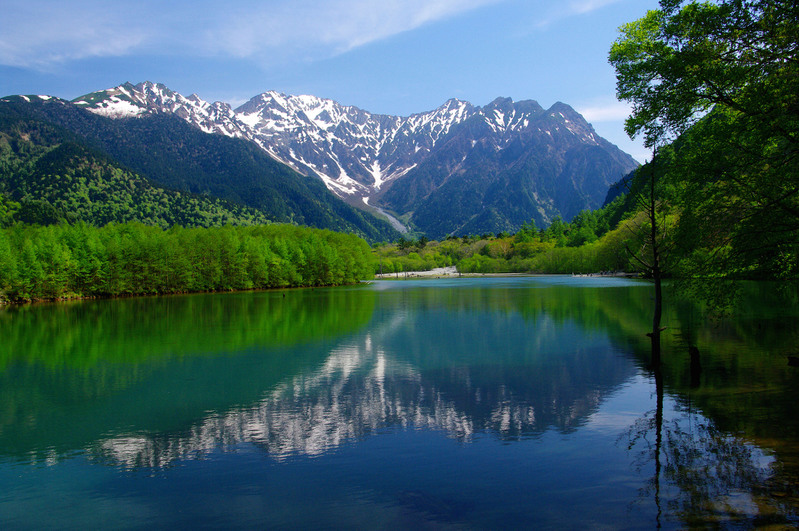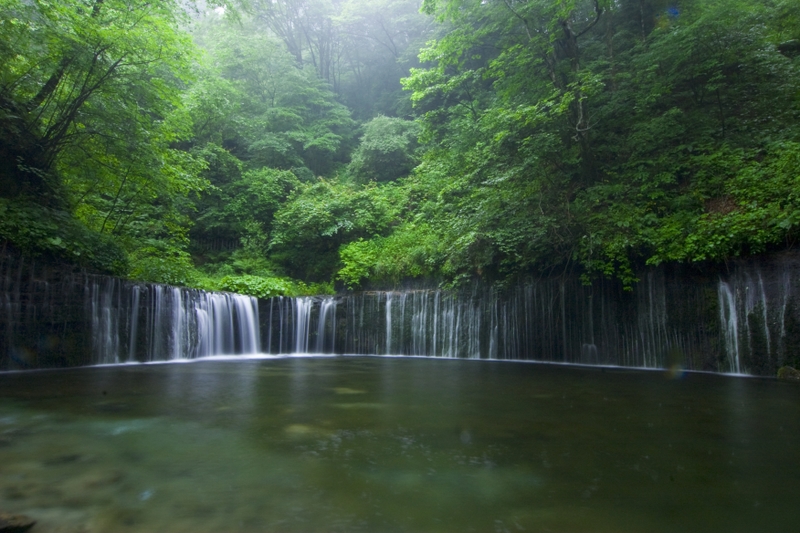15 of the Best Places to Visit in Nagano
Enjoy Nagano's wild natural scenery at its many national parks, historical sites and hot springs.
Update:2022/04/01

Looking to explore the Japanese Countryside but don’t know where to start? Look no further than Nagano.
Easily accessible from Tokyo, Nagoya and other major cities, it’s your gateway to the countryside and the majestic mountains of the Japanese Alps.
Here are our recommendations for 15 of Nagano’s best sightseeing spots.
1. Jigokudani Wild Monkey Park
In the Jigokudani Valley above the hot spring town of Yamanouchi, you’ll find steaming geothermal vents and a troupe of onsen-loving Japanese macaques.
It is said that the monkeys first discovered hot spring bathing after watching a man bathe in the outdoor bath of the nearby Korakukan inn. After locals witnessed the monkeys using the baths for themselves, they decided to set up a hot spring especially for them.
It’s no zoo&emdash;there are no fences separating the visitors from the monkeys. You can see them in their natural habitat as they bathe in hot springs and go about their everyday lives, up close and personal.
2. Matsumoto Castle

One of Japan’s few remaining original castles, Matsumoto Castle is a National Treasure and the proud symbol of Matsumoto City.
Its exquisite black-and-white exterior contrasts beautifully against the Northern Japanese Alps, and its interior includes a large museum of wartime artifacts, with many intact rifles and weapons from the Warring States Period. You can climb all the way up the castle's steep stairs—or are they more like ladders?—to the top of the castle and see Matsumoto City from above.
Around the castle you’ll find its jokamachi, old castle town streets with a rich history, featuring cozy cafes, shops and restaurants.
3. Zenkoji Temple

Zenkoji Temple is a national treasure with over 1,400 years of history.
The first Buddhist icon to be brought from India to Japan is enshrined here, making the temple an important pilgrimage spot for Buddhists in Japan. The saying goes that everyone should visit Zenkoji at least once in their lives.
There are 39 lodges around the temple where pilgrims stay and rest after their long journeys. Tourists can stay here as well and experience Zazen meditation, sutra-copying exercises and more.
4. Kamikochi

At the base of the Northern Japanese Alps is Kamikochi, an idyllic basin with crystal clear water and verdant forests. The views of the Hotaka mountain range from Kamikochi’s central Kappa Bridge are awe-inspiring and earn it a special place in the hearts of nature enthusiasts around Japan, and even around the world.
There are hours and hours of walking trails along the Azusa River, taking you to a number of scenic locales around the basin. You can also head into the mountains from Kamikochi, tackling day-trips to smaller mountains or going on multi-day treks to the highest peaks of the alps.
5. The Post Towns of the Nakasendo

The Nakasendo is a 534-kilometer-long trail that connects Kyoto and Tokyo. Constructed during the Edo Period (1603-1868), it was one of the longest but safest ways to travel between the old and new capital.
It was one of five major roads established at the time, but unlike others that have succumb to modernization, much of the Nakasendo has remained largely untouched. Parts of the road that people traveled hundreds of years ago, as well as the towns in which they stayed during their long journeys, can still be seen today.
Magome, Tsumago and Narai are the most well-preserved and popular post-towns to visit. Walk among these ancient townscapes and the old roads that connected them and experience a slice of Japan’s history.
6. Togakushi

This area, tied to Shinto legend, has long been a haunt of mountain ascetics. Five Shinto shrines were established here and are connected by a long trail leading to the foot of Mt. Togakushi.
The most famous among them is the final Okusha Shrine, which sits at the end of a 40-minute long trail through the woods. But more impressive than the shrine itself is the scenery along the way. Near the halfway point past a thatched-roof gate, you are greeted by rows of towering, 400-year-old trees. Nature seems to thrive around these Shinto shrines, and the area buzzes with a spiritual energy.

Due to its remote location and the lack of villages here, Togakushi was also an ideal location for ninja. The Togakure Ninja Museum, across from the entrance to the Okusha Shrine, is dedicated to the area’s history and has on display many of the tools that ninja used in their work.
7. Bessho Onsen
The small hot spring village of Bessho Onsen sits on a hill overlooking vast fields of rice. Home to several beautiful temples and one of Nagano’s national treasures, the village is also known as “Little Kamakura.”
Bessho is a place to relax and take life slow. Stay at a hot spring ryokan, leisurely soak in its bathes, and walk around town to see its ancient temples of Kitamuki Kannon and Anrakuji.
Stop to smell the roses the Bessho way, by taking a dip in one of the sotoyu (public) baths or tasting the hot spring water bubbling out of dragon-shaped fountains.
More about Hot Springs
Find other hot spring areas around Nagano
Learn about hot spring etiquette
8. Daio Wasabi Farm

Wasabi can’t be grown just anywhere. It requires a constant supply of clean, cool, free-flowing water. Thanks to snow melt from the Japanese Alps, the Daio Wasabi Farm produces plenty of wasabi and is one of the largest wasabi farms in Japan.
At the farm, you can taste fresh wasabi and wasabi-flavored snacks like croquettes, ice cream and even beer. You’ll be surprised by fresh wasabi’s subtle flavor—much less spicy than the preservative-filled green tubes that you find in supermarkets.
9. The Hakuba Valley
At the foot of the Japanese Alps, the Hakuba Valley is one of Japan’s premiere mountain resort areas. One of the stages for the 1998 Winter Olympic Games, it is well known for its plentiful powder snow and scenic ski resorts.
But winter isn’t the only time to visit, it’s a great place to enjoy the outdoors year-round. You can go mountain biking in the valley or on downhill trails, hike up its mountains, go canyoning in its ravines, or even paraglide through the sky.
For those looking for the best mountain views, we recommend visiting Happo Pond or Hakuba Mountain Harbor.
10. Karuizawa

A refreshing resort town in the mountains of Eastern Nagano and just 60 minutes away from Tokyo, Karuizawa is a great escape from the heat of summer.
Karuizawa strikes a fine balance between the style and comfort of the city and the fresh air and greenery of the countryside. The Karuizawa Prince Shopping Plaza embodies this concept, spreading out its over 220 outlet stores over green lawn and placid bodies of water. Karuizawa’s other main shopping areas, Kyu-karuizawa Ginza and the Harunire Terrace, are tucked into the woods at the foot of the mountains.
Further afield, Shiraito Falls is a must-see for nature lovers. This short but elegant waterfall traces a 70-meter arc, flowing like individual threads of white silk into the pool below.
11. Senjojiki Cirque
Japan’s first ropeway, located in the Central Japanese Alps, takes visitors over 2,600 meters high to see Senjojiki Cirque.
This natural amphitheater was formed by glacial activity over thousands of years. Its name refers to its vast size—so large that 1,000 tatami mats could be laid across it.
At these altitudes, you can see incredible scenery year-round. In winter and spring, the area is covered in snow and ice. In summer, colorful alpine flowers dot the landscape. In autumn, the low-lying bushes turn fiery shades of red and orange. And any time of year, you can see majestic views of the Southern Japanese Alps on the far side of the Ina Valley.
Learn More
Senjojiki Cirque and Komagane in Spring
12. The Tateyama Kurobe Alpine Route

The Tateyama Kurobe Alpine Route cuts through the mountains separating Nagano and Toyama prefectures with the use of cable cars, ropeways, trolleys and buses, introducing passengers to incredible alpine scenery.
Open from mid-April to early November, you can see massive snow walls in spring, greenery in summer, and vivid red and yellow foliage in autumn.
13. Star Village Achi
In the southernmost reaches of Nagano Prefecture is the small village of Achi. Removed from the cities and surrounded by mountains, Achi is a great place to enjoy the peace and quiet of nature while gazing at the stars. Take a lift up to the top of the local ski resort and enjoy the views from Star Village Achi.
As if an evening under the stars couldn't get any more relaxing, the area is also known for its steamy hot spring baths. Most visitors spend the night at one of the inns here at Hirugami Onsen, whose waters are known for their rejuvenating properties.
While far from most parts of Nagano, the area is just 1 hour and 40 minutes from Nagoya by bus.
14. Obuse
The town of Obuse sits by the shore of the Chikuma River between Suzaka and Nakano cities in Northern Nagano. Surrounded by plentiful farmland and placed conveniently between Zenkoji Temple and the Sea of Japan, it long served as a hub for trade and travel.
One of the area’s most famous guests, who ended up living here for many years, was Katsushika Hokusai, whose works are some of the most well-known images of Japanese art outside of Japan (see: "the Great Wave off Kanagawa").
The Hokusai Museum was dedicated to him and houses many of the works that he made while he was here, and on the outskirts of town, Gansho-in Temple has one of his most beautifully preserved paintings.
15. The Venus Line

Extending across the central highlands of Nagano, the Venus Line takes you past serene lakes, expansive moors and majestic mountains at altitudes from 1,500 to 2,000 meters high.
Drive through grassy highlands covered in day lilies, pass idyllic pastures with grazing cattle, and stop to admire the contrast of natural and man-made beauty at the Utsukushigahara Open Air Museum.

Driving in Japan may seem daunting at first, but it opens up so much more of what Japan has to offer, especially when visiting the countryside. And if you do choose to drive, it's hard to beat the scenery that the Venus Line has to offer.
Learn More
Renting a Car in Nagano Two days of driving around the Roof of Japan
















